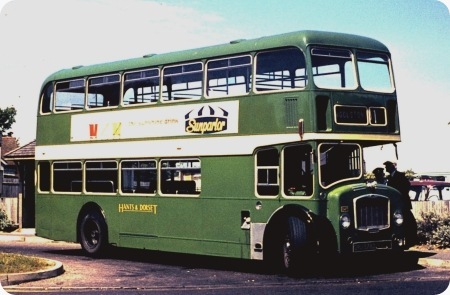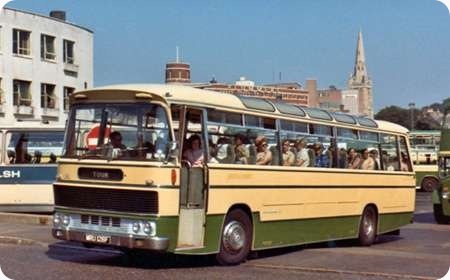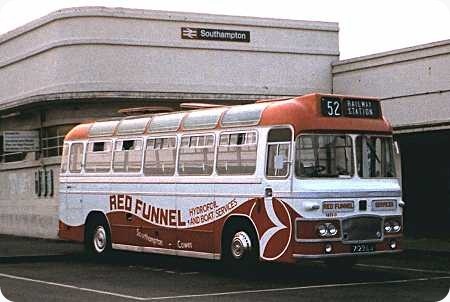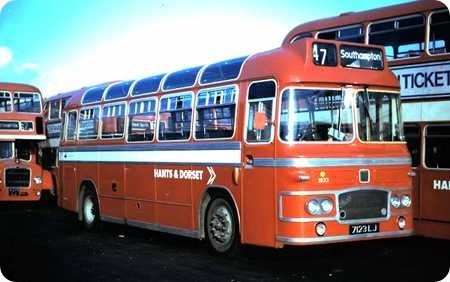
Copyright Pete Davies
Hants & Dorset Motor Services
1966
Bristol Lodekka FLF6B
ECW H38/32F
In case readers were thinking the bulk of my photographs are of operators in the Midlands and North of England, here is something to balance matters. GRU978D was a Bristol FLF6B in the Hants & Dorset fleet. She is seen on the sunny morning of 29 May 1970, and is at Hamble Square, ready to return to Woolston on the 81.
I believe she went to the USA when withdrawn.
Photograph and Copy contributed by Pete Davies
A full list of Bristol codes can be seen here.
14/08/12 – 06:51
As a young enthusiast on the south coast, Hants and Dorset was my nearest Tilling operator, often seen at Fareham, and Southampton. In those days, I sometimes felt that Tilling companies (BTC, then THC) were all "much the same". That was before the impact of NBC – then we really knew what "all the same" meant! Here in the south, I reflect that it was possible to distinguish between the green Tilling companies (Hants and Dorset, Southern/Western National, Bristol Omnibus) or red ones (Wilts and Dorset, Thames Valley) by little idiosyncrasies as fleet number application (plates or transfers), the obvious registration letters used, and even destination indicator styles. Although the screen layout was an evolving national policy, somehow the style of the text differed between these operators – or was it just my imagination!? Several of these fleets also contained a number of vehicles unique to themselves. At Hants and Dorset, there were all-Leyland PD2s (highbridge), some NCME-bodied Regents (diverted from Western SMT), and H&D’s own open-top rebuilds with full-fronts. I think these bodies started on some pre-war Bristol Ks, and were transferred successively over a few years to some war-time Ks, and finally to some post-war Ks. These bodies, I believe, were rebuilt by H&D’s works from the original Brush bodies supplied pre-war (as ordinary half-cab double-deckers). So the FLF in the picture would have been "standard viewing" at the time, but brings great pleasure now. Incidentally, the name Hants and Dorset has disappeared, but the company became owned by Wilts and Dorset after privatisation (a reversal of the NBC era, when H&D controlled W&D!). But under modern W&D control, the H&D subsidiary is now called "Damory Coaches". While in Weymouth last week, I photographed two Olympians – but they weren’t sailing – just waiting near the King’s Statue on the seafront for their return journey on their Olympic charter. Much too modern for this site, but they did look proud in the sunshine.
Michael Hampton
14/08/12 – 11:37
Have no history whatsoever with Hants & Dorset, but always preferred the Bristol engine. H & D had some of the rare (late) Leyland engined FLFs. I only learned recently that this option was put on the list after the Bristol engine was removed from it.
Looking at this picture though, it shows the perfect proportions of the FLF body. Balance and symmetry are always the basis of a good design.
David Oldfield
14/08/12 – 11:39
Rob Sly has an excellent website listing preserved Bristol Lodekka buses, VR, LH and RE. This bus did go to USA and was red in 2011 which is the last update – full details at //bcv.robsly.com/
Ken Jones
15/08/12 – 07:55
As far as I’m aware, one of the main reasons Northern bought Routemasters was United’s introduction of this type of Loddeka onto the routes they operated jointly. Northerns RD Park Royal PD2’s were getting a bit long in the tooth, and although the PDR1 Atlantean had been in service with Northern for a couple of years it was decided to go for the Routemaster instead. Being a BET company, Northern never had any of these, but that all changed with the formation of NBC, when for reasons best known to the powers that be, long established fleets were shuffled around like decks of cards. I cant remember the exact number, but at Percy Main we had some Daimler Fleetlines transferred to United in exchange for Loddeka’s, but they only stayed a matter of a few weeks and were replaced by the AEC Renowns that came from East Yorkshire, the Bristol’s going on to other depots. I remember one or two drivers being caught out by the gearbox, where it wasn’t possible to go into neutral from fifth without going through forth. Digressing back to fleet reshuffles, some depots got buses from as far afield East Kent and Maidstone and District, make sense of that if you can.
Ronnie Hoye
15/08/12 – 07:56
On the fringes (in two respects) to what Michael H said about name changes, I notice that neighbour Wilts & Dorset are re-naming their Bournemouth and Poole operation ‘MORE’! Bizarre!
Chris Hebbron
15/08/12 – 07:57
Can’t help but agree with you David, on the ‘just right’ proportions of the FLF. Handsome machines from any angle. Hants & Dorset did indeed have some FLFs with Leyland (0.600) engines, as did Wilts & Dorset. Interestingly, both fleets also specified semi-auto gearboxes to mate up with them. I could never understand however, why H&D had to change it’s livery from green to red under NBC ownership. Surely it can’t have been to differentiate between the H&D and Provincial (green) fleets. A similar fate befell West Riding Auto up here in the ‘Olympic Medal County’ of Yorkshire, where WR’s green fleet went red under NBC. Strangely, this meant that its fleet livery was then the same as associate company Yorkshire Woollen District, which retained its red. Maybe someone could explain?!
Brendan Smith
15/08/12 – 11:30
Chris H, there are rumblings that the name SALISBURY REDS is being extended from just the company’s activities in that City to Romsey and other routes as well, while MORE is being extended from Bournemouth and Poole to include Lymington. It’s being said that the W&D name will vanish (again) from bus sides, though I understand that it will remain as the legal lettering.
Brendan, going on from that, the history of Wilts & Dorset to 1972 includes a reference to the green to red transition of Hants & Dorset. It has nothing to do with trying to distinguish from Provincial. When the joint management of H&D/W&D were told that the W&D name was to be dropped, they were so disgusted by the dropping of such a highly respected name they decided "We’re going red".
Pete Davies
15/08/12 – 11:31
No logic in the halls of NBC Brendan. Maroon East Midland became leaf green.
David Oldfield
15/08/12 – 14:55
Wasn’t NBC policy a poor attempt at LT/Greenline… Country services to be green, urban services red? If I recall, a lot of the "used" Wulfrunian replacements at WR had arrived in green… and I think stayed that way…?? Anyway, privatised WR went back to green, if not the same one…. Of course, WR had once been part red anyway!
Joe
19/08/12 – 07:52
This must be the smartest design of all ECW double decker Bristols
Jim Hepburn
19/08/12 – 07:54
David, I seem to remember that East Midland (maroon) absorbed Mansfield District (green), is that when East Midland went green?
Vernon Ford
19/08/12 – 08:30
That’s very true, Vernon – but it’s no excuse! [I read recently a theory that NBC went green for rural and red for urban – but that doesn’t explain Hants & Dorset going from green to red!] …..and of course the blues (East Yorkshire and Midland General) had to go red.
None of this would have been half so bad if Tilling Red, Green and Cream had been retained. Visually – and on quality – they were better than Leaf Green and Poppy Red which faded within the year.
David Oldfield
19/08/12 – 12:00
I seem to recall reading somewhere that certain bus companies which had their origins in tramways, and which had not set up a separate company later to operate buses, were therefore statutory companies (i.e. set up by Acts of Parliament). The Acts specified in very minute detail the activities of the operator and in some cases this could even specify the livery that would be used (though obviously not in the majority of cases as many tramway operators changed their liveries). I believe Mansfield District was such a case, and the green livery on the bus fleet could only be changed by another Act of Parliament, which would have been too much hassle, so when East Midland took them over it was easier to adopt a green livery for the entire fleet. Has anyone else heard of this?
John Stringer
19/08/12 – 15:05
This may be right- I think, John S, that tramways regulations were why West Riding ran a red fleet on the old tram routes, and there might be some obscure connection with the centre entrances?
Joe
20/08/12 – 07:59
John, regarding your comments on statutory companies and Acts Of Parliament, I seem to recall reading something similar about Provincial surviving as a fleet in its own right for a similar reason, after acquisition by NBC. Even though Provincial came under Hants & Dorset administrative control, the fleetname and green livery were retained, whereas Wilts & Dorset, a larger NBC subsidiary, was swept away altogether under NBC ‘rationalisation’. If the above is correct, was another Act of Parliament actually passed when NBC was privatised? If it wasn’t, on a mischievous note, wouldn’t it be nice to inform First Group that Provincial’s fleetname and livery must be reinstated….?
Brendan Smith
20/08/12 – 08:00
Joe, am I right in thinking that West Riding trams were red and buses green? (why the difference? – a subsidiary company operated the buses to start with?? [time to consult bookshelf!]) and this difference perpetuated on the Wakefield-Leeds tram-replacement buses because those services operated "jointly" with the Rothwell-Leeds services of LCT. Red WR buses could carry local passengers, green buses could not. I think the distinction was ended after LCT bought out Wallace Arnold’s Kippax & District (also Farsley Omnibus Co) operations: a coordination agreement (see V4 of John Soper’s/LTHS’s excellent history of LCT et al) was subsequently entered into in respect of the Leeds-Garforth corridor, which allowed (green) WR buses to carry local passengers – so the retention of red buses on the "track" was pointless, although as there were still WR services that couldn’t pick up in Leeds I suppose WR could have painted Leeds-Garforth buses in red as well. Whatever, with all these (in many cases poorly advertised) restricted carrying arrangements – which varied from town to town – in force is it any wonder that passengers deserted the bus?
I’m going to stick my neck out here and say that this red "urban"/green "rural" NBC livery theory is a load of tosh – Alder Valley (a new company) went red – and it’s territory can hardly be described as urban – as did East Yorkshire (ditto, country-wise) when it changed colour. Cumberland, Ribble, West Yorkshire, Eastern Counties, East Kent (and the previously-mentioned Hants & Dorset) – all with large rural areas stayed/went red. I remember reading, many years ago when the privatisation BA livery was introduced, that even office furniture down to desk tidies was changed: the logic being that corporate means the same throughout, down to the last item. I’ve read that NBC (and their design consultants!) wanted to go "poppy red all over" but that that the managers of green fleets put forward a strong-enough case for that colour to be retained. The blue fleets weren’t so lucky, in the long run: no standard blue was decided on and the choice of colour was left down to the Regional Chairman: Stratford Blue had gone by this time; Midland General was told to go red, after a period in which it painted it’s buses in NBC-style "Balfour Beatty" blue; EYMS and Sunderland District were allowed to stay (their own) blue by the Regional Chairman ([sic] I think, as NBC seemed to have a habit of changing Regional boundaries around this time), but Sunderland District was then absorbed by Northern – and that just left EYMS with a non-standard indigo livery, which then succumbed . . . except for plucky little Jones. Now I’ve heard that when the directors of Jones sold out to NBC they insisted that the the Jones identity AND blue be preserved for ten years – would that fit in with when the Jones identity disappeared under MAP? Wholly-urban Provincial and (OK, this is pushing it) Bristol Joint Services and "Bath Services" stayed green, and indeed, Cheltenham District went green. Red "urban". green "rural"? – seems like a London-centric fixation.
Philip Rushworth
20/08/12 – 09:06
Nah, Philip. My body’s down south but my heart’s still in the north.
David Oldfield
20/08/12 – 11:40
Nay Philip, I haven’t a clue. West Riding buses were green except the red ones on the old tram routes- Leeds and, I think, Ossett. These had centre entrances and, I think, double staircases (like trams?!) An early example of route branding, but can anyone confirm the fundamental reason? Was it passenger co-ordination, or tramway legislation? After all, Yorks Woollen latterly ran into Leeds in red….
I still think that deep in the NBC head office was the belief that buses were born either green or red, and green ones ran in leafy suburbs. The fact that this didn’t work across the country was only realised later….
Joe
20/08/12 – 13:56
Just a small point arising from Philip Rushworth’s comment on Alder Valley. When Aldershot and District was, in effect, taken over by Thames Valley – one of the best BET companies being swallowed up by one of the worst BTC ones – to form Alder Valley in January 1972, the livery initially adopted was maroon, on the rather tenuous pretext that this was the colour formed by mixing TV red and A&D green. London Country Bus Services next door already used a green livery, so that, when the dead hand of Freddy Wood’s standardisation came to be applied, the maroon became red.
Roger Cox
20/08/12 – 13:58
Brendan, When the Barbie livery was introduced, along with the dropping of the local fleetnames, I wrote to the local branch of First to suggest the very same thing in respect of Provincial. The then MD wrote back to say they had considered this, but weren’t worried. From that, I guess the disposal of certain fleetnames may have been written into the 1985 Act, but I must admit I’ve never read it.
Pete Davies
21/08/12 – 07:34
As well as Bristol staying green so did Crosville who were a very urban operator in the north of their territory.
Chris Hough
21/08/12 – 08:32
Yes Chris, but outside Bristol and Liverpool/Wirral they were both very rural.
David Oldfield
21/08/12 – 20:29
We can surely add Eastern National and United Counties to the list of the NBC "Greens" with much urban mileage.
Roger Cox
24/08/12 – 08:26
Joe
The fundamental reason, was I think, that red buses on "the track" (Leeds-Wakefield) were joint/coordinated with LCT buses on Leeds-Rothwell (both having been jointly-worked/coordinated tram services) and could pick-up within the LCT area. The significance of this distinction ended when green WR buses on the Leeds-Garforth corridor were also allowed to pick-up within the LCT boundary following a co-ordination agreement with LCT on that corridor.
Philip Rushworth
04/02/13 – 06:59
Further to the query regarding the survival of Gosport & Fareham under NBC, I well remember Peter Hunt, then General Manager at H&D/G&F telling me that, as G&F was a Statutory Company, an Act of Parliament would be necessary to extinguish it. At that time (around 1977) the estimated legal costs of such an Act was £30,000, which was not considered justified. In any case, Peter Hunt said in a public meeting at which I was present "I think small is beautiful" he thought the efficiency benefits of small-unit cohesion far outweighed any possible advantage from scrapping it. Would that the current crop of industry managers had his wisdom!
David Jones
04/02/13 – 09:58
It’s statutory status probably stemmed from its creation as a tram company. I would have thought, though, that the name could merely have been discontinued and/or the company made moribund. It looks as if the small is beautiful, and a certain affection for this quirky organisation by Peter Hunt and well-loved by locals and enthusiasts alike, won the day! And hooray for that! Shame it never happened to equally loved and respected Samuel Ledgard.
Chris Hebbron
25/06/13 – 07:40
Here’s one for Lodekka enthusiasts… I once boarded a Hants & Dorset FS which featured something I’ve never ever seen on any other Lodekka – it had an opening top vent in the nearside rear lower bulkhead window. I know this to be true, but can anyone shed any light on this particular vehicle?
Colin Plucknett
25/06/13 – 11:45
Coincidence can be a funny thing. I’m travelling at present but have a number of models with me to show to/sell to a friend. One is a Corgi Lodekka FS being Hants and Dorset 1512, CEL 860C. This is modelled with a top opening light in the nearside front bulkhead window so I presume that all that batch, at least, had them.
Phil Blinkhorn
25/06/13 – 11:47
Colin both West Yorkshire and Crosville also had an opening window on the front lowerdeck window on their FS Lodekkas.
Chris Hough
28/06/13 – 07:22
Thanks very much Phil and Chris for your interesting replies – however, the window I am thinking of is one of the pair in the rear downstairs. I have since turned up one half-shot from a book and you can just see what I mean. It really is a rare thing – and at least it proves I’m not going mad!!! Any further ideas chaps?
Colin Plucknett
13/12/13 – 16:55
In case anyone is curious, the last H&D FLF 1577, LLJ 443F, is preserved and appears annually at the King Alfred Running day in Winchester, on 1st January. Free rides all day on part of the 47 road, all welcome.
Alex Geisler
 Vehicle reminder shot for this posting
Vehicle reminder shot for this posting
13/02/14 – 17:01
When Hants and Dorset was split up into smaller units Wilts and Dorset was one of the resulting companies.
To rename buses from Hants and Dorset to Wilts and Dorset the simple expedient of printing some stickers that read "WIL" and placing them over the "HAN" of Hants and Dorset was used.
David R





